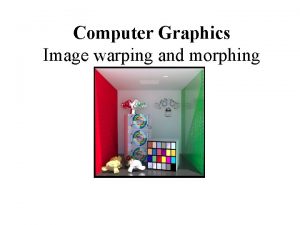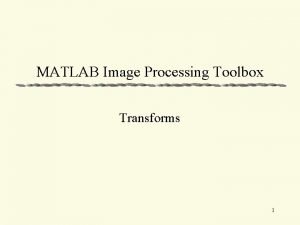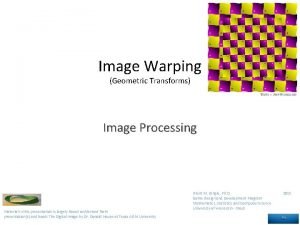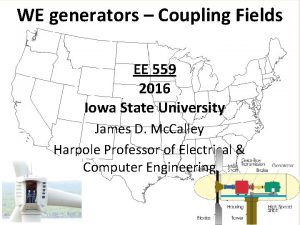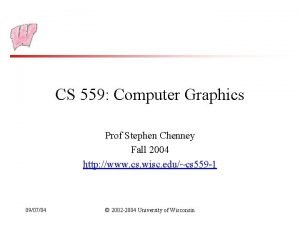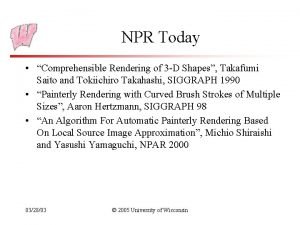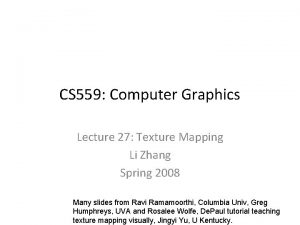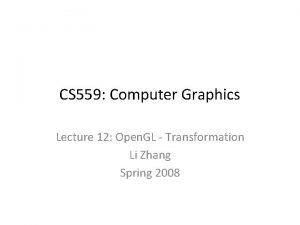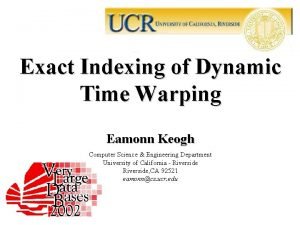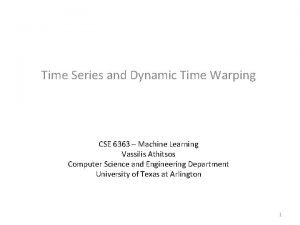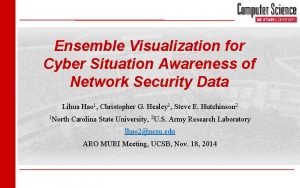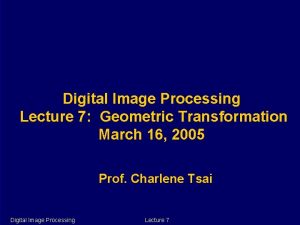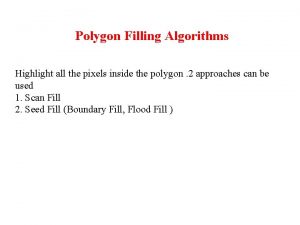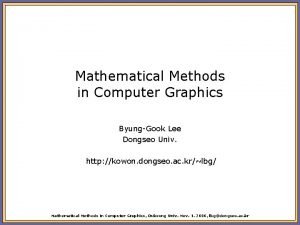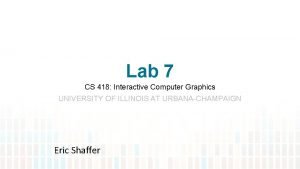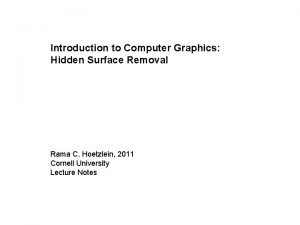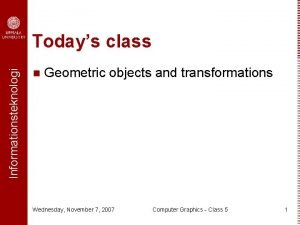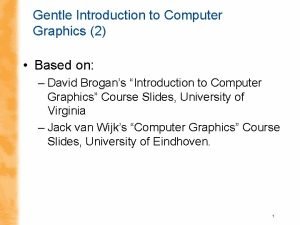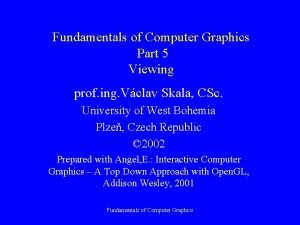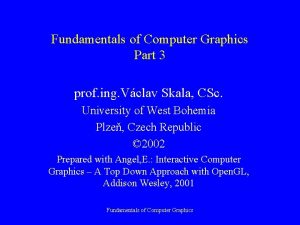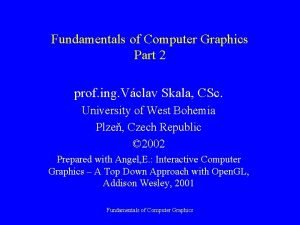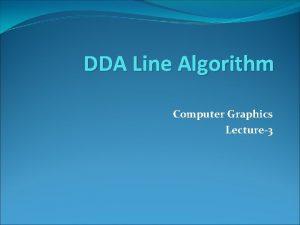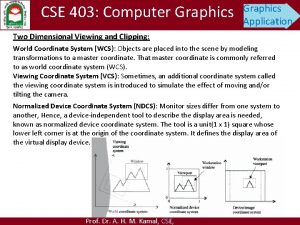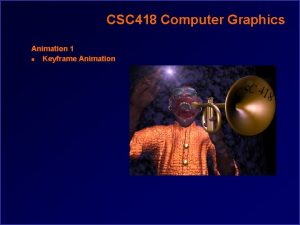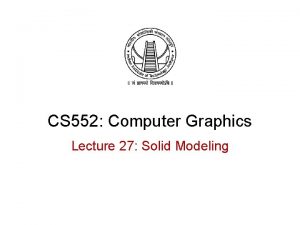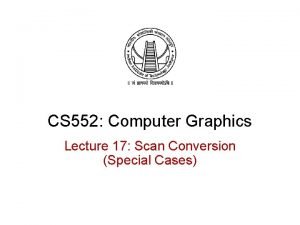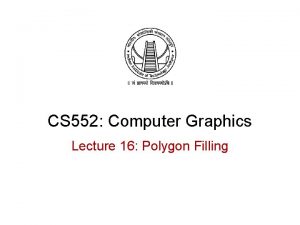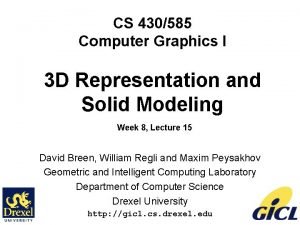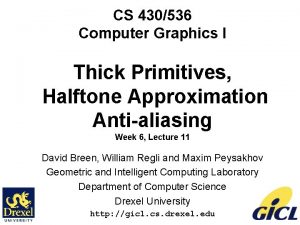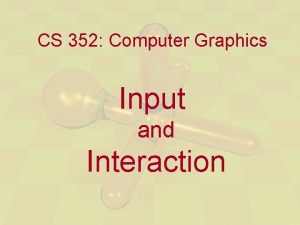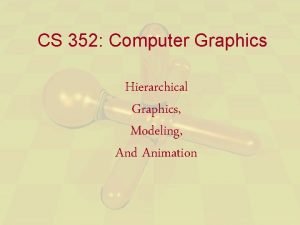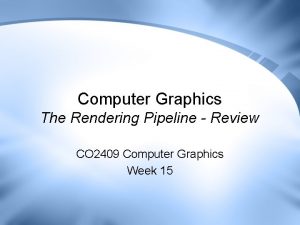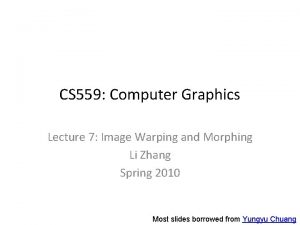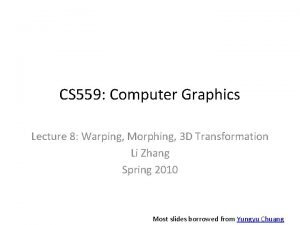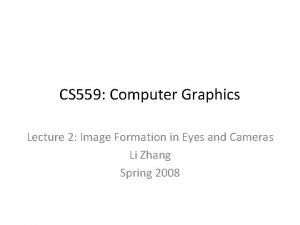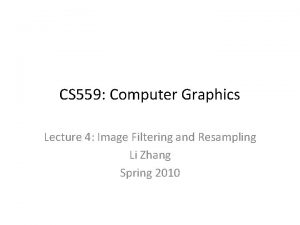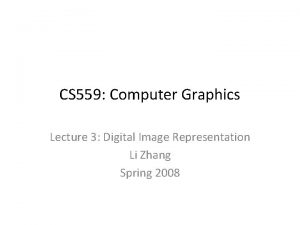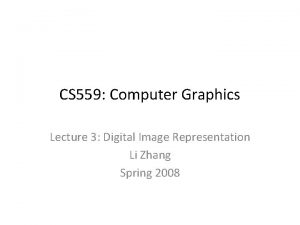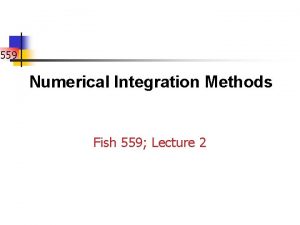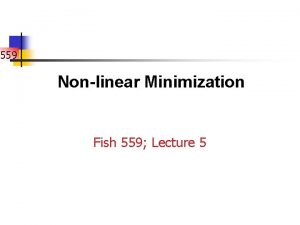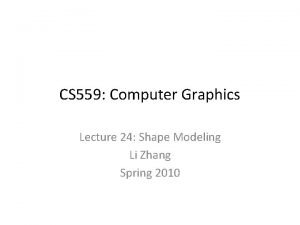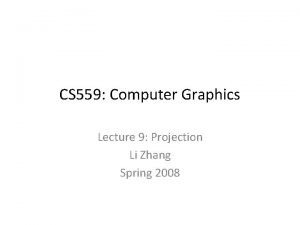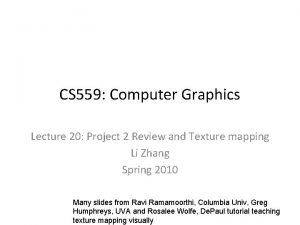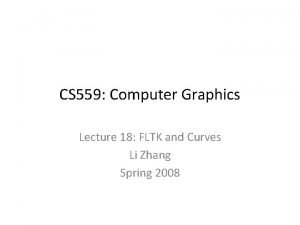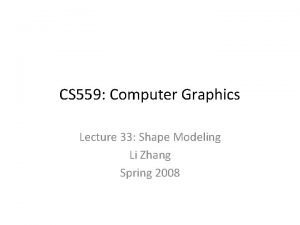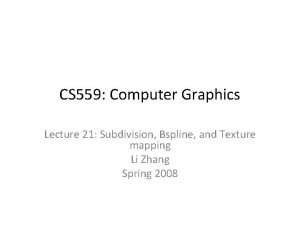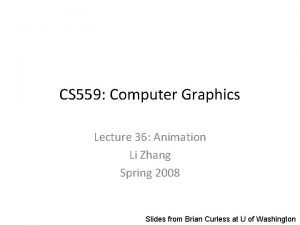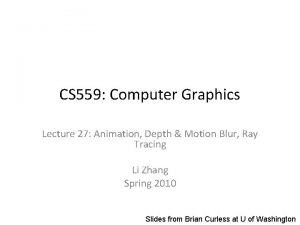CS 559 Computer Graphics Lecture 7 Image Warping


![Image Manipulation • Changing pixel values • Moving pixels around h([x, y])=[x, y/2] f Image Manipulation • Changing pixel values • Moving pixels around h([x, y])=[x, y/2] f](https://slidetodoc.com/presentation_image_h2/1c5e950fb442b2732318c8c51453add4/image-3.jpg)




![Parametric (global) warping h([x, y])=[x, y/2] T p = (x, y) p’ = (x’, Parametric (global) warping h([x, y])=[x, y/2] T p = (x, y) p’ = (x’,](https://slidetodoc.com/presentation_image_h2/1c5e950fb442b2732318c8c51453add4/image-8.jpg)




























![Non-parametric image warping • Specify a more detailed warp function [x, y] T [x’, Non-parametric image warping • Specify a more detailed warp function [x, y] T [x’,](https://slidetodoc.com/presentation_image_h2/1c5e950fb442b2732318c8c51453add4/image-37.jpg)


























- Slides: 63

CS 559: Computer Graphics Lecture 7: Image Warping and Panorama Li Zhang Spring 2008 Most slides borrowed from Yungyu Chuang

Today • Image Warping and Morphing • Reading – – Shirley, Ch 5, Linear Algebra Shirley, Ch 6. 1, 2 D Transform Shirley, Ch 6. 3, Translation, p 151 -152(1 st paragraph) (Optional) Image morphing: a survey, George Wolberg, Visual Computer 1998
![Image Manipulation Changing pixel values Moving pixels around hx yx y2 f Image Manipulation • Changing pixel values • Moving pixels around h([x, y])=[x, y/2] f](https://slidetodoc.com/presentation_image_h2/1c5e950fb442b2732318c8c51453add4/image-3.jpg)
Image Manipulation • Changing pixel values • Moving pixels around h([x, y])=[x, y/2] f h g

Parametric (global) warping Examples of parametric warps: translation affine rotation perspective aspect cylindrical

Application of Image Warp Mosaics: stitching images together Creating virtual wide-angle camera

Application of Image Warp Texture mapping Creating realistic surface appearance http: //www. futuretech. blinkenlights. nl/tex. html

Application of Image Warp • Morphing image #1 morphing image #2
![Parametric global warping hx yx y2 T p x y p x Parametric (global) warping h([x, y])=[x, y/2] T p = (x, y) p’ = (x’,](https://slidetodoc.com/presentation_image_h2/1c5e950fb442b2732318c8c51453add4/image-8.jpg)
Parametric (global) warping h([x, y])=[x, y/2] T p = (x, y) p’ = (x’, y’) • Transformation T is a coordinate-changing machine: p’ = T(p) • What does it mean that T is global? – can be described by just a few numbers (parameters) – the parameters are the same for any point p • Represent T as a matrix: p’ = Mp

Scaling • Scaling a coordinate means multiplying each of its components by a scalar • Uniform scaling means this scalar is the same for all components: g f 2

Scaling • Non-uniform scaling: different scalars per component: x 2, y 0. 5

Scaling • Scaling operation: • Or, in matrix form: scaling matrix S What’s inverse of S?

2 -D Rotation (x’, y’) (x, y) x’ = x cos( ) - y sin( ) y’ = x sin( ) + y cos( )

2 -D Rotation • This is easy to capture in matrix form: x’ = x cos( ) - y sin( ) y’ = x sin( ) + y cos( ) R • How can I remember this? • Even though sin( ) and cos( ) are nonlinear to , – x’ is a linear combination of x and y – y’ is a linear combination of x and y • What is the inverse transformation? – Rotation by – – For rotation matrices, det(R) = 1

2 x 2 Matrices • What types of transformations can be represented with a 2 x 2 matrix? 2 D Identity? 2 D Scale around (0, 0)?

2 x 2 Matrices • What types of transformations can be represented with a 2 x 2 matrix? 2 D Rotate around (0, 0)? 2 D Shear?

2 x 2 Matrices • What types of transformations can be represented with a 2 x 2 matrix? y’ y 1 1 (1, 1) shx shy 0 1 2 D Shear? x 0 1 x’

2 x 2 Matrices • What types of transformations can be represented with a 2 x 2 matrix? 2 D Mirror about Y axis? 2 D Mirror over (0, 0)?

All 2 D Linear Transformations • Linear transformations are combinations of … – Scale, – Rotation, – Shear, and – Mirror • Any 2 D transform can be decomposed into the product of a rotation, scale, and a rotation

All 2 D Linear Transformations • Linear transformations are combinations of … – Scale, – Rotation, – Shear, and – Mirror • A symmetric 2 D transform can be decomposed into the product of a rotation, scale, and the inverse rotation

All 2 D Linear Transformations • Linear transformations are combinations of … – Scale, – Rotation, – Shear, and – Mirror • Properties of linear transformations: – Origin maps to origin – Lines map to lines – Parallel lines remain parallel – Ratios are preserved – Closed under composition

2 x 2 Matrices • What types of transformations can not be represented with a 2 x 2 matrix? 2 D Translation? NO! Only linear 2 D transformations can be represented with a 2 x 2 matrix

Translation • Example of translation tx = 2 ty = 1 Homogeneous Coordinates

Affine Transformations • Affine transformations are combinations of … – Linear transformations, and – Translations • Properties of affine transformations: – Origin does not necessarily map to origin – Lines map to lines – Parallel lines remain parallel – Ratios are preserved – Closed under composition – Models change of basis

Image warping • Given a coordinate transform x’ = T(x) and a source image I(x), how do we compute a transformed image I’(x’) = I(T(x))? T(x) x I(x) x’ I’(x’)

Forward warping • Send each pixel I(x) to its corresponding location x’ = T(x) in I’(x’) T(x) x I(x) x’ I’(x’)

Forward warping fwarp(I, I’, T) { for (y=0; y<I. height; y++) for (x=0; x<I. width; x++) { (x’, y’)=T(x, y); I’(x’, y’)=I(x, y); } } I T I’ x x’

Forward warping • Send each pixel I(x) to its corresponding location x’ = T(x) in I’(x’) • What if pixel lands “between” two pixels? • Will be there holes? • Answer: add “contribution” to several pixels, normalize later (splatting) h(x) x f(x) x’ g(x’)

Forward warping fwarp(I, I’, T) { for (y=0; y<I. height; y++) for (x=0; x<I. width; x++) { (x’, y’)=T(x, y); Splatting(I’, x’, y’, I(x, y), kernel); } } I I’ T x x’

Splatting • Computed weighted sum of contributed colors using a kernel function, where weights are normalized values of filter kernel k, such as Gauss May get a blurry image! p radius d q Destination Image for all q q. color = 0; q. weight = 0; for all p from source image for all q’s dist < radius d = dist(p, q); w = kernel(d); q. color += w*p; q. weight += w; for all q q. Color /= q. weight;

Inverse warping • Get each pixel I’(x’) from its corresponding location x = T-1(x’) in I(x) T-1(x’) x I(x) x’ I’(x’)

Inverse warping iwarp(I, I’, T) { for (y=0; y<I’. height; y++) for (x=0; x<I’. width; x++) { (x, y)=T-1(x’, y’); I’(x’, y’)=I(x, y); } } T-1 I I’ x x’

Inverse warping • Get each pixel I’(x’) from its corresponding location x = T-1(x’) in I(x) • What if pixel comes from “between” two pixels? • Answer: resample color value from interpolated source image x f(x) x’ g(x’)

Inverse warping iwarp(I, I’, T) { for (y=0; y<I’. height; y++) for (x=0; x<I’. width; x++) { (x, y)=T-1(x’, y’); I’(x’, y’)=Reconstruct(I, x, y, kernel); } } T-1 I I’ x x’

Reconstruction (interpolation) • Possible reconstruction filters (kernels): – nearest neighbor – bilinear – bicubic – sinc

Bilinear interpolation (triangle filter) • A simple method for resampling images

Non-parametric image warping
![Nonparametric image warping Specify a more detailed warp function x y T x Non-parametric image warping • Specify a more detailed warp function [x, y] T [x’,](https://slidetodoc.com/presentation_image_h2/1c5e950fb442b2732318c8c51453add4/image-37.jpg)
Non-parametric image warping • Specify a more detailed warp function [x, y] T [x’, y’]

Non-parametric image warping • Specify a more detailed warp function • Tabulate pixel motion (lookup table)

Non-parametric image warping • Mappings implied by correspondences • Inverse warping ? P’

Non-parametric image warping

Warping between two triangles A’ A C’ B C B’ • Idea: find an affine that transforms ABC to A’B’C’

Warping between two triangles A’ A C’ B C B’ • Idea: find an affine that transforms ABC to A’B’C’ • 6 unknowns, 6 equations

Barycentric coordinates • Idea: represent P using A 1, A 2, A 3

Barycentric coordinates • Idea: represent P using A 1, A 2, A 3

Barycentric coordinates • Idea: represent P using A 1, A 2, A 3

Non-parametric image warping Barycentric coordinate P P’ Turns out to be equivalent to affine transform

Non-parametric image warping Gaussian

Demo • http: //www. colonize. com/warp 04 -2. php • Warping is a useful operation for mosaics, video matching, view interpolation and so on.

Image morphing

Image morphing • The goal is to synthesize a fluid transformation from one image to another. • Cross dissolving is a common transition between cuts, but it is not good for morphing because of the ghosting effects. image #1 dissolving (1 -t) ∙ Image 1 + t ∙ Image 2 image #2

Image morphing • Why ghosting? • Morphing = warping + cross-dissolving shape (geometric) color (photometric)

Image morphing image #1 warp cross-dissolving morphing image #2 warp

Morphing sequence

Image morphing create a morphing sequence: for each time t 1. Create an intermediate warping field (by interpolation) A(0. 33) A(0) C(0) B(0) t=0 B(0. 33) t=0. 33 A(1) C(0. 33) C(1) B(1) t=1

Image morphing create a morphing sequence: for each time t 1. Create an intermediate warping field (by interpolation) 2. Warp both images towards it A(0. 33) A(0) C(0) B(0) t=0 B(0. 33) t=0. 33 A(1) C(0. 33) C(1) B(1) t=1

Image morphing create a morphing sequence: for each time t 1. Create an intermediate warping field (by interpolation) 2. Warp both images towards it A(0. 33) A(0) C(0) B(0) t=0 B(0. 33) t=0. 33 A(1) C(0. 33) C(1) B(1) t=1

Image morphing create a morphing sequence: for each time t 1. Create an intermediate warping field (by interpolation) 2. Warp both images towards it 3. Cross-dissolve the colors in the newly warped images A(0. 33) A(1) A(0) C(0) B(0) t=0 B(0. 33) t=0. 33 C(0. 33) C(1) B(1) t=1

More complex morph • Triangular Mesh

Results Michael Jackson’s MTV “Black or White” http: //www. michaeljackson. com/quicktime_blackorwhite. html

Multi-source morphing

Multi-source morphing

The average face • http: //www. uniregensburg. de/Fakultaeten/phil_Fak_II/Psycholo gie/Psy_II/beautycheck/english/index. htm

3 D Face morphing http: //www. youtube. com/watch? v=nice 6 NYb_WA Blanz and Vetter, SIGGRAPH 1998
 Warping in computer graphics
Warping in computer graphics Amber
Amber Image processing toolbox
Image processing toolbox Affine image warping
Affine image warping Graphics monitors and workstations and input devices
Graphics monitors and workstations and input devices Introduction to computer graphics ppt
Introduction to computer graphics ppt Ee 559
Ee 559 Cs 559
Cs 559 Cs 559 uw madison
Cs 559 uw madison Cs 559
Cs 559 G&l
G&l Point out
Point out Dynamic time warping
Dynamic time warping Morphing
Morphing Exact indexing of dynamic time warping
Exact indexing of dynamic time warping Dynamic time warping stock market
Dynamic time warping stock market Introduction to dsp
Introduction to dsp Dynamic time warping
Dynamic time warping 01:640:244 lecture notes - lecture 15: plat, idah, farad
01:640:244 lecture notes - lecture 15: plat, idah, farad Image processing lecture notes
Image processing lecture notes Image processing lecture
Image processing lecture Computer security 161 cryptocurrency lecture
Computer security 161 cryptocurrency lecture Computer aided drug design lecture notes
Computer aided drug design lecture notes Computer architecture lecture notes
Computer architecture lecture notes Isa vs microarchitecture
Isa vs microarchitecture Crt in computer graphics
Crt in computer graphics What is viewing in computer graphics
What is viewing in computer graphics Video display devices
Video display devices Exterior clipping
Exterior clipping Shear transformation in computer graphics
Shear transformation in computer graphics Acos glsl
Acos glsl What is scan conversion in computer graphics
What is scan conversion in computer graphics Computer graphics
Computer graphics What are two different region filling algorithms
What are two different region filling algorithms Advantages and disadvantages of boundary fill algorithm
Advantages and disadvantages of boundary fill algorithm Polygon filling algorithm in computer graphics
Polygon filling algorithm in computer graphics Random scan display in computer graphics
Random scan display in computer graphics Computer graphics
Computer graphics Line drawing of computer
Line drawing of computer Cs 418 interactive computer graphics
Cs 418 interactive computer graphics Cs 418 interactive computer graphics
Cs 418 interactive computer graphics Hidden surface removal in computer graphics
Hidden surface removal in computer graphics Achromatic light in computer graphics
Achromatic light in computer graphics What are the interactive input methods? explain in detail
What are the interactive input methods? explain in detail Uniform scaling in computer graphics
Uniform scaling in computer graphics Uniform scaling in computer graphics
Uniform scaling in computer graphics Orthogonal projection in computer graphics
Orthogonal projection in computer graphics Logical input devices in computer graphics
Logical input devices in computer graphics Fundamentals of computer graphics
Fundamentals of computer graphics Ppt
Ppt Introduction to computer graphics ppt
Introduction to computer graphics ppt Dda line drawing algorithm
Dda line drawing algorithm In two dimensional viewing system have
In two dimensional viewing system have Csc418
Csc418 Sweep representation in computer graphics
Sweep representation in computer graphics Scan conversion in computer graphics
Scan conversion in computer graphics Flood fill algorithm in computer graphics
Flood fill algorithm in computer graphics Utah teapot vertex data
Utah teapot vertex data Thick primitives in computer graphics
Thick primitives in computer graphics Interaction in computer graphics
Interaction in computer graphics Hierarchical modeling in computer graphics
Hierarchical modeling in computer graphics Rendering pipeline in computer graphics
Rendering pipeline in computer graphics Circle in computer graphics
Circle in computer graphics Srgp in computer graphics
Srgp in computer graphics

